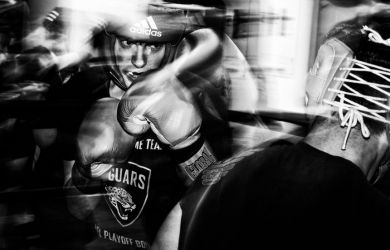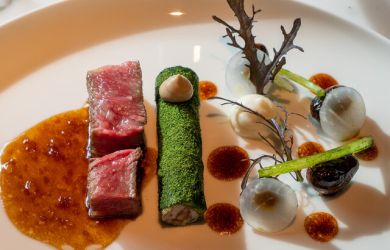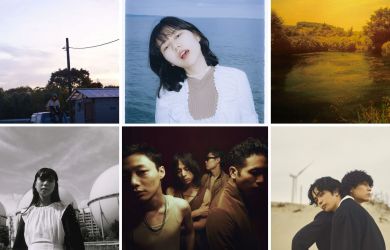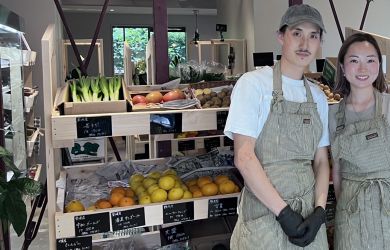
July 9, 2009
Made in Tokyo
Foreign filmmakers are queuing up to work on location in the city. But that's easier said than done
By Metropolis
Originally published on metropolis.co.jp on July 2009

Vladimir Zakharov (www.vladimirzakharov.net)
In the 1967 movie You Only Live Twice, James Bond is seen fleeing from a crime syndicate whose headquarters is actually the Hotel New Otani. Fast-forward to 2006 and there are cars tearing through the streets of Shibuya at night in The Fast and the Furious: Tokyo Drift—well, give or take a bit of CGI. The film’s depiction of Shibuya was actually created using special effects, and very little of the movie was filmed on location in Japan.
Western audiences might presume that filmmakers are just getting lazier, but the real story is more complicated. A host of restrictions and regulations have made Tokyo a much more difficult place to shoot a movie than it was when 007 rode on the Marunouchi line and took in a sumo tournament. Famed Mexican director Alejandro Gonzalez Inarritu, who filmed part of his 2006 Golden Globe winner Babel in Tokyo’s J-Pop Cafe, complained at a press conference at the time that the Tokyo government needed to do far more to make it easier for foreign filmmakers.
While some directors resort to guerrilla filmmaking to get a few authentic shots, most producers of big-budget films give up due to the high costs and the red tape. All too often, Tokyo ends up being reproduced on a California movie set, or elsewhere. In Quentin Tarantino’s 2003 film Kill Bill: Vol. 1, a restaurant resembling Nishi-Azabu’s popular Gonpachi was recreated in a Beijing studio for the famous swordfight sequence in which Uma Thurman decimates an entire yakuza gang.
To help facilitate filmmaking for both foreign and domestic movie studios and TV producers, the Tokyo Metropolitan Government set up Tokyo Location Box in 2001. The office provides information on which locations may be used for filming, how to obtain permission from police and local authorities, and what facilities are available for postproduction and recording. However, a look at the numbers shows how difficult it is to actually get permission. In 2008, Tokyo Location Box received 2,333 domestic requests and 56 overseas inquiries. Permission was given in only 146 cases, most of which were from Japan. The few foreign projects were documentaries and independent productions.
Contrast this with cities such as New York and Los Angeles, which have a high-profile mayor’s office that handles film, theater and broadcasting. Hundreds of movies and TV shows are shot each year in those cities, generating millions of dollars in revenue and employing thousands of locals, ranging from production crews to caterers. It’s not uncommon for a city to close off a few blocks to shoot action sequences—for example, I Am Legend in New York or Heat in LA.

©2009 Emperor Dragon Movies Limited. All Rights Reserved. 「協力 台東区フィルムコミッション」
“We don’t have as much of a history as the film commissions in big cities like New York and Los Angeles, so we are not able to provide as much support as they can,” admits Hajime Endo, chief coordinator for Tokyo Location Box. “We receive requests directly from the producers of foreign productions. There is sometimes a coordinator who serves as the intermediary… [but] all we can really do is provide interested productions with information concerning possible sites based on their preferences, and inform them of steps they need to take in order to gain permission to film there. If the producer has a certain location in mind, we serve as the go-between between them and the manager of that location in order to help them with the planning.”
Masako Nakayama, director of Tokyo Location Box, says the most sought-after locations in Tokyo are Kabukicho, Shibuya crossing, Ginza and Senso-ji temple. Yet permission is routinely denied by the authorities in all four cases. “The reason is because there are too many people,” she explains. “You can’t park cars or secure space in crowded areas, and police in Tokyo never allow the closing of certain streets for filming like they do in New York. Certain crowded spots around train stations are also off-limits. You can film in some parks and on bridges, as long as you get permission. With complexes like Roppongi Hills or other office buildings, you need to talk directly with the private companies that own them.”
Nakayama acknowledges that these restrictions often lead filmmakers to shoot guerrilla style, the most celebrated example being Sofia Coppola’s Lost in Translation. “If it’s not to an extreme degree, it will probably go unnoticed and the crew won’t have to run the gauntlet with police,” she says. “On the other hand, many productions don’t bother and just find it easier to create a set in the US that looks like it’s in Shibuya, such as with The Fast and the Furious. Even Jackie Chan’s new movie, Shinjuku Incident, wasn’t shot in Shinjuku. They filmed some scenes in Taito Ward and did the rest in Kobe.”
Taito Ward is one of five regional film commissions within Tokyo that have been actively inviting movie productions, including foreign ones, to come shoot in their hometowns. (The other four are Hachioji, Tachikawa, Hino and Hachijojima.) More than 200 films used Taito Ward locations in 2008, including the recent Japanese movie Twentieth Century Boys, which was shot in Hino, where about 70 films are made annually.
The rules tend to be more relaxed in the suburbs than in central Tokyo, says Nakayama. “The Tokyo Metropolitan Police Department is very strict on even minor points. Not only that, a filmmaker has to get the approval of local residents—a lot of the time, that is a major obstacle. Even if the filming is in the middle of the night and no one is being inconvenienced, there have been cases where locals say no to their area being used because the scene involved some wild car chase or heinous crime.”

©2009 Emperor Dragon Movies Limited. All Rights Reserved. 「協力 台東区フィルムコミッション」
The producers of recently released action film Rain Fall had to shoot their on-location scenes quickly, before anyone had a chance to complain. One chase scene was filmed in Akihabara over two days, including a Sunday. A spokesperson for the producers said the crew frantically sought to disperse the crowd as the characters ran through them. If a single person were to inadvertently look at the video camera, the scene would have to be reshot. So the crew went through numerous takes, and each time, the cast could only hope that no one would notice what was going on. Filming other scenes entailed reserving an entire train car of the Rinkai line and employing 400 extras, and using the former Chiyoda Ward office to depict the police station and ministry of infrastructure.
Hotels are also favorite locations for filmmakers—especially those of the five-star variety. The Park Hyatt in Shinjuku has enjoyed lasting fame since the release of Lost in Translation in 2003. “We continue to receive interest from around the world for filming of scenes for movies, commercials, documentaries and TV programs,” says international PR manager Karina Shima. However, wannabe Tokyo filmmakers encounter the same problems in hotels as they do on the street.
“As a rule, we are unable to accommodate requests for filming because our foremost concern is the comfort and privacy of hotel guests,” Shima continues. “As Lost in Translation was shot after-hours and in confined spaces, filming was allowed. Consent was given upon review of the script, which was felt to be true to the style and spirit of the hotel.”
Another factor was the relatively small scale of the production: “The film was shot with a small, lightweight camera on high-speed film that required no intrusive, extra lighting. From the beginning, the agreed time frame for filming within the hotel was short—less than a month. The crew was downsized to a minimum number and worked quickly and nimbly. Hotel staff members worked closely with them to make the shoot as unobtrusive as possible. All of the filming of public spaces was done after-hours, in order not to disturb guests,” recounts Shima.
The Imperial Hotel in Hibiya is particularly sensitive about the use of its public spaces for filming, and as a rule the management declines such requests. “Exceptions would be made after careful consideration and on a case-by-case basis when the subject matter involves individuals who are or were hotel personnel,” says Nacio Cronin, the Imperial Hotel’s director of international public relations. “For example, the recent NHK TV series based on our late Grand Chef and culinary world celebrity, Nobuo Murakami, where the private shooting was limited to our ballrooms and kitchens. Or when the film is one of significant artistic quality and all shooting can be done during the early morning hours without inconveniencing any of our guests.”

©2009 Emperor Dragon Movies Limited. All Rights Reserved. 「協力 台東区フィルムコミッション」
The Imperial Hotel also made exceptions for the ’60s Hollywood film My Geisha with Shirley MacLaine and Yves Montand, and a more recent Luc Besson Hollywood movie, Wasabi, with Jean Reno. “A few parts were shot in the main lobby entirely during the very wee hours of the morning,” says Cronin.
For the Hilton Tokyo in Shinjuku, it depends on the subject matter, says PR spokeswoman Momoko Gonohe. “We won’t give permission for filming of scenes which feature a murder or a sexual act in guest rooms. When we do accept filming, we usually charge for one full day and only accept shooting from noon until 8pm. Items with logos are removed from guestrooms, and we ask the producers not to show or use the name Hilton.”
Meanwhile, the Mandarin Oriental Tokyo in Mitsukoshi-mae will be seen in the upcoming Japanese film Hagetaka (“Vulture”), a continuation of the 2007 NHK show about corporate takeovers. “We usually turn down this type of request,” says PR spokeswoman Chie Hayakawa. “But since the hotel itself is featured in the story as it is, and the drama has a high profile with a good story, we said OK.”
Increasingly, foreign filmmakers are being attracted to a different, grittier side of Tokyo—its neon-drenched streets, pachinko parlors, love hotels, nightclubs and neighborhood noodle bars, as seen in films such as The Ramen Girl (2008) and the upcoming Map of the Sounds of Tokyo, by Spanish director Isabel Coixet. Starring Rinko Kikuchi and Sergi Lopez, Map tells the story of a fish-market worker and occasional contract killer who is hired to bump off a liquor store owner devastated by his girlfriend’s suicide.
While indie films like Map will continue to be made in Tokyo, big Hollywood productions seem unlikely. When Tom Cruise was in Japan in 2006 to promote Mission: Impossible III, he expressed a desire to film in the city. “I’d like to shoot a future movie in downtown Tokyo for a week,” he said during a meeting with the then transport minister. “Just at night. It would be an unbelievable sequence.”
Now that would be an impossible mission.
Chris Betros is the editor of Japan Today (www.japantoday.com). Additional reporting by Satomi Honda
Here’s a list of prominent foreign movies filmed in Tokyo… or were they?
- Walk Don’t Run
Cary Grant, in his last film, traipses through the Hotel Okura and around Toranomon during the Tokyo Olympics - You Only Live Twice
James Bond visits the Hotel New Otani, a sumo tournament, the Marunouchi subway line and Yoyogi - The Yakuza
Robert Mitchum takes on a gang in-between visits to coffee shops, Shinjuku pubs and kendo schools - Gung Ho
Cocky American Michael Keaton goes to Tokyo at the start of the movie to convince an auto company to open a factory in his city. While there, he experiences the joys of sleeping in a capsule hotel, Akihabara, McDonald’s, Tokyo station—and a rice paddy - Tokyo Pop
A punk rocker (Carrie Hamilton) heads to Japan in search of celebrity amid karaoke lounges in Shinjuku and Shibuya - Wasabi
Jean Reno is the French cop who goes to Tokyo for the reading of an old girlfriend’s will and learns that he has a daughter he never knew about. Locations include various nightclubs, the Imperial Hotel and Harumi Passenger Ship Terminal - Lost in Translation
Bill Murray and Scarlett Johansson form a friendship at the Park Hyatt, and also venture out to Shibuya and Daikanyama - Kill Bill: Vol. 1
Uma Thurman takes revenge on yakuza boss Lucy Liu and 88 goons at the Japanese restaurant House of Blue Leaves—modeled on Gonpachi in Nishi-Azabu, but recreated in a Beijing studio. Only some outdoor driving scenes were filmed in Tokyo - The Grudge
Sarah Michelle Gellar is an American nurse living in a haunted house in Aoyama (and Toho Studios in Nerima-ku) - Babel
One third of the movie deals with a mute, sexually confused teenager (Rinko Kikuchi), with scenes filmed in Shinjuku, Shibuya’s J-Pop Café and on the illuminated Chuo-Ohashi roadway - The Fast and Furious: Tokyo Drift
Lots of drift racing on the streets of Tokyo at night—except it’s not really Shibuya, just the magic of special effects - The Ramen Girl
Brittany Murphy, dumped by her boyfriend and stranded in Tokyo, gets some tips on noodles and life from tyrannical ramen chef Toshiyuki Nishida - Rain Fall
CIA agents chase a Japanese-American assassin around the subways, Akihabara and Narita Airport





